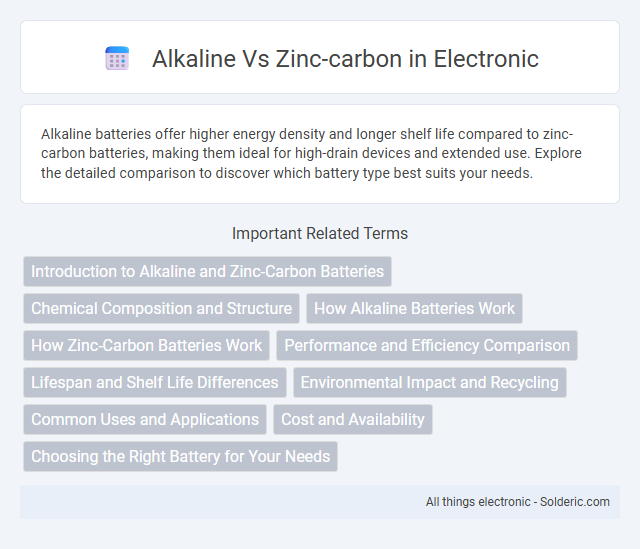Alkaline batteries offer higher energy density and longer shelf life compared to zinc-carbon batteries, making them ideal for high-drain devices and extended use. Explore the detailed comparison to discover which battery type best suits your needs.
Comparison Table
| Feature | Alkaline Battery | Zinc-Carbon Battery |
|---|---|---|
| Chemistry | Manganese dioxide and zinc with alkaline electrolyte (potassium hydroxide) | Zinc and manganese dioxide with acidic electrolyte (ammonium chloride or zinc chloride) |
| Voltage | 1.5 volts nominal | 1.5 volts nominal |
| Capacity | Higher capacity, typically 2000-3000 mAh for AA size | Lower capacity, typically 400-1000 mAh for AA size |
| Cost | More expensive | Less expensive |
| Performance | Longer shelf life, better performance under high-drain devices | Shorter shelf life, suitable for low-drain devices |
| Leakage Risk | Lower risk of leakage | Higher risk of leakage over time |
| Environmental Impact | Less toxic, contains fewer harmful metals | Contains more toxic materials, higher environmental risk |
| Common Use | High-drain devices like digital cameras, flashlights, toys | Low-drain devices like remote controls, clocks, flashlights |
Introduction to Alkaline and Zinc-Carbon Batteries
Alkaline and zinc-carbon batteries are common types of disposable power sources used in everyday devices. Alkaline batteries feature a zinc anode and manganese dioxide cathode with an alkaline electrolyte, offering higher energy density and longer shelf life compared to zinc-carbon batteries, which utilize a zinc anode and a carbon rod cathode with acidic electrolyte. Your choice between these batteries impacts device performance, cost, and environmental footprint.
Chemical Composition and Structure
Alkaline batteries utilize a zinc anode and manganese dioxide cathode with an alkaline potassium hydroxide electrolyte, offering higher energy density and longer shelf life. Zinc-carbon batteries contain a zinc anode, ammonium chloride or zinc chloride electrolyte, and a manganese dioxide cathode, which results in lower cost but reduced capacity and lifespan. The electrolyte type and internal structure differences fundamentally impact performance, with alkaline batteries providing more stable voltage and better resistance to leakage.
How Alkaline Batteries Work
Alkaline batteries work by utilizing a chemical reaction between zinc metal and manganese dioxide, producing electrical energy through the movement of electrons from the anode to the cathode via an electrolyte made of potassium hydroxide. The electrochemical reaction in alkaline batteries offers higher energy density and longer shelf life compared to zinc-carbon batteries, which rely on an acidic paste electrolyte and zinc anode with a carbon cathode. This efficient electron flow and stable electrolyte composition allow alkaline batteries to deliver more consistent power output and improved performance in high-drain devices.
How Zinc-Carbon Batteries Work
Zinc-carbon batteries operate through an electrochemical reaction between zinc as the anode and manganese dioxide as the cathode, with an acidic electrolyte facilitating ion movement. The zinc casing acts as the negative electrode, oxidizing and releasing electrons, while the manganese dioxide gains electrons, completing the circuit and generating electrical energy. This simple design provides a low-cost power source ideal for low-drain devices, though it typically offers lower capacity and shorter life compared to alkaline batteries.
Performance and Efficiency Comparison
Alkaline batteries deliver higher energy density and longer shelf life compared to zinc-carbon batteries, making them more efficient for high-drain devices. Zinc-carbon batteries perform adequately in low-drain applications but tend to have lower voltage stability and shorter lifespan under heavy use. When choosing power sources, your decision should consider the specific device requirements, prioritizing alkaline for sustained performance and zinc-carbon for cost-effective, short-term use.
Lifespan and Shelf Life Differences
Alkaline batteries generally offer a longer lifespan than zinc-carbon batteries, delivering significantly higher energy density and sustained power for high-drain devices. Their shelf life extends up to 7-10 years due to lower self-discharge rates compared to zinc-carbon batteries, which typically last 3-5 years before noticeable degradation. This makes alkaline batteries ideal for long-term storage and usage in electronics requiring consistent performance.
Environmental Impact and Recycling
Alkaline batteries have a lower environmental impact compared to zinc-carbon batteries due to their longer lifespan and reduced leakage of toxic materials like mercury and cadmium. Zinc-carbon batteries contain higher levels of heavy metals, which pose greater risks to soil and water contamination if not properly disposed of. You can support environmental sustainability by recycling both types through designated programs that recover valuable metals and minimize landfill waste.
Common Uses and Applications
Alkaline batteries are widely used in high-drain devices such as digital cameras, flashlights, and portable electronics due to their higher energy density and longer shelf life. Zinc-carbon batteries find common application in low-drain devices like remote controls, clocks, and basic flashlights where cost-effectiveness is prioritized over longevity. Both battery types serve essential roles in powering household electronics, with alkaline preferred for performance-intensive gadgets and zinc-carbon favored for budget-friendly, low-power usage.
Cost and Availability
Alkaline batteries typically cost more than zinc-carbon batteries but offer longer-lasting power, making them cost-effective for high-drain devices. Zinc-carbon batteries are cheaper and widely available, often used for low-drain electronics due to their lower energy density. Both types are easily accessible in retail stores, but alkaline batteries dominate in terms of market availability and variety.
Choosing the Right Battery for Your Needs
Alkaline batteries provide higher energy density and longer shelf life, making them ideal for high-drain devices like digital cameras and remote controls. Zinc-carbon batteries are more cost-effective and suitable for low-drain devices such as clocks or flashlights where battery life is less critical. Selecting the right battery depends on balancing performance requirements and budget, with alkaline offering superior durability and zinc-carbon delivering economical power for basic use.
Alkaline vs Zinc-carbon Infographic

 solderic.com
solderic.com